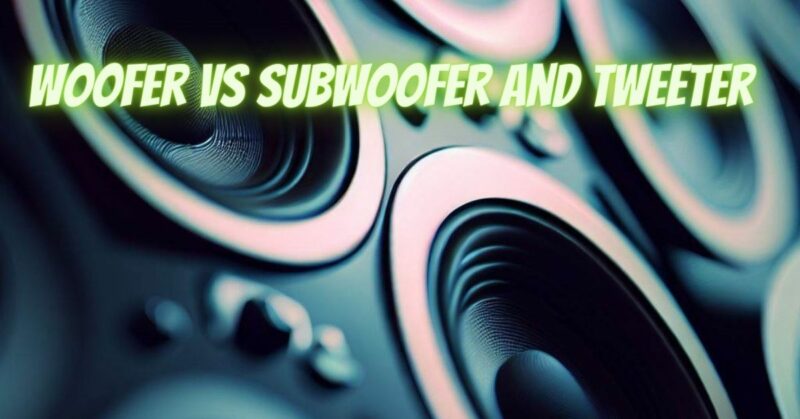When it comes to understanding speaker systems, it’s important to be familiar with the different components that contribute to audio reproduction. Two key components are woofers and subwoofers, which handle low-frequency sounds, and tweeters, which handle high-frequency sounds. In this article, we will explore the differences between woofers, subwoofers, and tweeters, their respective roles in speaker systems, and how they work together to deliver a balanced and immersive listening experience.
- Woofer: A woofer is a speaker driver responsible for reproducing low-frequency sounds, typically ranging from around 40Hz to 2kHz. It is commonly found in two-way or three-way speaker systems. The woofer’s design allows it to move larger volumes of air, producing the mid-bass and mid-range frequencies that give depth and fullness to music and other audio content. Woofer sizes can vary, with larger diameters typically producing deeper bass response.
- Subwoofer: A subwoofer is a specialized speaker designed specifically for handling the lowest frequencies in the audio spectrum, typically below 120Hz. Subwoofers are dedicated to reproducing deep bass notes with power and precision, providing a visceral and impactful listening experience. They are often used in home theater systems and dedicated audio setups to enhance the low-end performance of the overall sound system. Subwoofers are typically larger in size than woofers and may require a separate amplifier for optimal performance.
- Tweeter: A tweeter is responsible for reproducing high-frequency sounds, typically ranging from around 2kHz to 20kHz and beyond. Its purpose is to handle the upper register of audio content, including vocals, cymbals, and other high-pitched instruments. Tweeters are designed to accurately reproduce the intricate details and nuances of high-frequency sounds, ensuring clarity and definition in the overall sound reproduction. They are often found in conjunction with woofers or subwoofers to create a balanced frequency response across the audible spectrum.
- Integration and Crossover: In a multi-driver speaker system, such as a two-way or three-way configuration, woofers, subwoofers, and tweeters work together in harmony. A crossover network is used to divide the audio signal into appropriate frequency ranges for each driver. The crossover directs low-frequency signals to the woofers and subwoofers, while high-frequency signals are sent to the tweeters. This division of frequencies ensures that each driver focuses on its designated frequency range, optimizing their performance and preventing distortion.
- Speaker System Design: The design of speaker systems varies depending on the desired audio performance and application. Two-way speaker systems consist of a woofer and a tweeter, covering the low and high frequencies respectively. Three-way systems add a mid-range driver to handle the frequencies between the woofer and tweeter. In systems that include subwoofers, they are typically dedicated to handling the lowest frequencies, while the woofers handle the mid-bass and mid-range frequencies.
- Achieving Balanced Sound: Proper integration and balance between woofers, subwoofers, and tweeters are crucial for achieving accurate and immersive sound reproduction. The combination of these components allows for a wide frequency response, ensuring that all aspects of the audio content are faithfully reproduced. Balancing the output levels and frequencies of each driver, as well as considering room acoustics, can help achieve a cohesive and well-rounded soundstage.
| Feature | Woofer | Subwoofer | Tweeter |
|---|---|---|---|
| Frequency range | 40 Hz to 2 kHz | 20 Hz to 200 Hz | 2 kHz to 20 kHz |
| Size | Typically 8 inches to 12 inches in diameter | Typically 10 inches to 18 inches in diameter (or larger) | Typically 2 inches to 4 inches in diameter |
| Power output | Typically 50 to 200 watts | Typically 100 to 1,000 watts (or more) | Typically 10 to 100 watts |
| Purpose | To reproduce low-frequency sounds | To reproduce the lowest frequencies | To reproduce high-frequency sounds |
Conclusion:
Woofers, subwoofers, and tweeters are essential components of speaker systems, each playing a specific role in delivering a balanced and immersive listening experience. Woofers handle mid-bass and mid-range frequencies, while subwoofers specialize in deep bass reproduction. Tweeters, on the other hand, excel at reproducing high-frequency sounds with clarity and precision. By understanding the distinctions between these components and their integration within speaker systems, you can appreciate the intricate balance of frequencies and enjoy a more accurate and satisfying audio experience.


